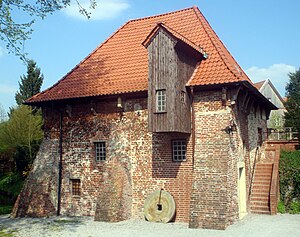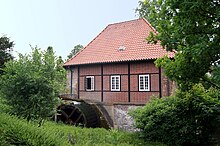Bischofsmühle (Coesfeld)
| Bischofsmühle Coesfeld
|
||
|---|---|---|
|
The massive construction of the Coesfeld Bischofsmühle is rather untypical for watermills in Münsterland. |
||
| Location and history | ||
|
|
||
| Coordinates | 51 ° 56 '16 " N , 7 ° 11' 16" E | |
| Location | Bischofsmühle 10, 48653 Coesfeld , NRW , Germany |
|
| Waters | Honigbach ( GWK 92842) | |
| Built | 12th Century | |
| Shut down | 1955, crushed until 1965 | |
| Status | Functional museum mill. | |
| technology | ||
| use | Flour mill | |
| drive | Watermill | |
| water wheel | overshot, renewed in 1986 | |
| Website | Bischofsmühle at the DGM . | |
The Bischofsmühle is a water mill in Coesfeld with an overshot water wheel .
location
The Bishop mill is located on Honey Brook towards the so-called jack , where formerly a passage through the city of Hagen called Landwehr was. This location is a good kilometer southeast outside the city walls of the medieval Coesfeld.
history
In its foundations, the Bischofsmühle is the oldest building in the Munsterland district town of Coesfeld. Its origins are in the 12th century. The often quoted date of 1214 on the weir is, however, an oversight; the correct number is 1714 and refers to a renovation.
The Honigbach that drives the mill was only moved to its current bed after 1248 to feed the Coesfeld moat. Before that it flowed over the bed of the Hornebach to the Tüskenbach. The massive construction, which is atypical for mills - the walls are up to a meter thick - suggests that the building existed at this location before the creek was laid and that it was used for another purpose, such as a fortress or refuge, until it was converted into a mill , served.
The designation as Bischofsmühle ( Bischopinck-Molle ) indicates that the mill was formerly owned by the Bishop of Münster . In his fiefdom history, a Grymoldings mill is mentioned as early as the beginning of the 12th century, which was associated with the Coesfeld farms of Grimping and Hüppelswick. Possibly it was already the mill that still exists today.
An oil mill was probably built opposite the Bischofsmühle in the 14th century , so that the system represented a double mill typical of the Münsterland. Grain and oil mill, the latter no longer exists today, as well as the surrounding lands including the fish ponds that are still in existence today were sold to Johann von Graes zur Loburg in 1598 . In 1624 the mill was leased to a miller for the first time . In 1894 the mill became the property of judge Peter von Hamm.
Ten years later, in 1904, the then miller Hubert Seesing acquired the property around the mill for 45,000 gold marks . In 1955 the production of fine flour was stopped, ten years later the milling for animal feed production was also given up and the mill was finally shut down. The last miller, Heinrich Seesing, was able to experience how the mill was renovated from 1984 and put under monument protection by the city of Coesfeld in 1985 . In 1986 the wooden water wheel was renewed. Today, the Bischofsmühle is a fully functional museum mill with equipment from around 1900, which uses modern generator technology to generate electricity from the energy of the flowing water . The mill regularly takes part in the German Milling Day .
Web links
Individual evidence
- ^ Alois Schwarz, Bernhard Fritsche: Old mills in the Münsterland . 2nd, revised and expanded edition. Aschendorff , Münster 1991, ISBN 3-402-05265-2 , p. 99 f .
- ↑ a b See the leaflet in the mill to take away. This leaflet contains a collection of the display boards set up in the building with information on the history of the mill and the miller's trade .




